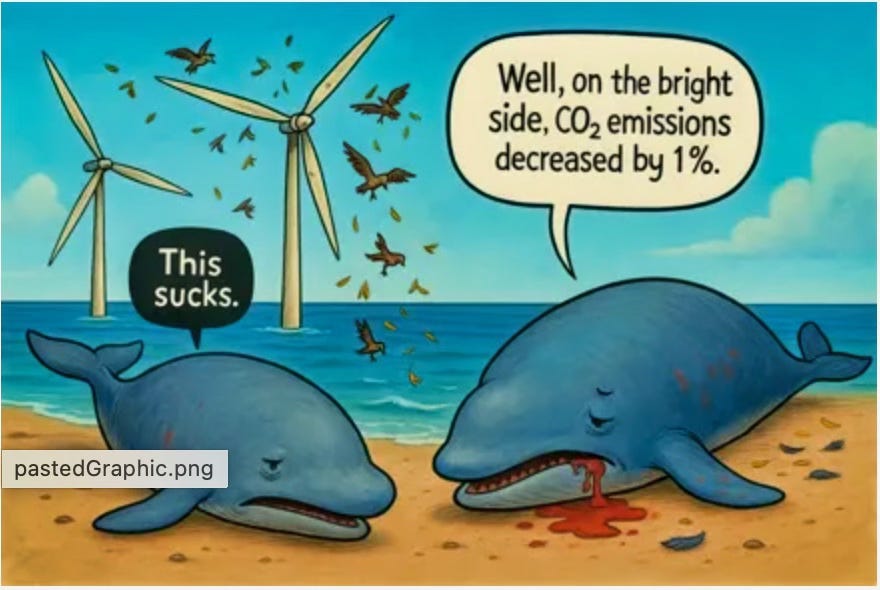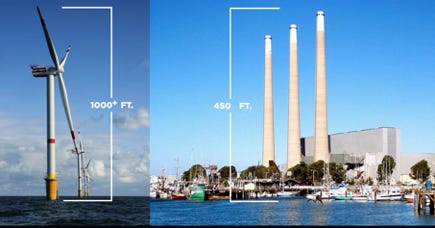As I sat with my wife’s family for my birthday dinner this past weekend at Goleta Beach, everyone marveled at the view of the ocean from our table. I couldn’t help but say, “Now imagine it covered in hundreds of Eiffel tower-sized machines.”
The Central Coast not only borders the Pacific Ocean; it thrives beside it. From Point Mugu to Monterey Bay, our economy, culture, and identity are connected to it.
Along the way up the Central Coast, you hit Morro Bay with its unique feature, Morro Rock, a Chumash cultural site. Just offshore from Morro Bay, past the fishing boats, lies one of the richest marine ecosystems on Earth. Anchovies feed whales and seabirds. Kelp forests shelter rockfish and abalone. Cold upwelling waters drive a coastal food chain that has sustained life and livelihoods for thousands of years, since the first Chumash arrived.
This could all be threatened by a plan that favors foreign profits, California’s activist climate policies, and their supporting NGOs.
The federal government has leased 400 square miles of ocean off Morro Bay for an industrial-scale floating offshore wind (FLOW) farm of 300 turbines, each over 1,000 feet tall, with 350-foot blades. These turbines will be visible from shore. They will require massive industrial harbor upgrades, large anchoring systems, constant vessel traffic, extensive electric cable runs throughout the water, and permanent infrastructure in the bay.
To put this FLOW area into perspective, it is about the size of Los Angeles, located directly offshore in our ocean, with hundreds of miles of anchor chains and cables in the water.
Harnessing Offshore Wind
Figure 1. General Overview of Offshore Wind - UCSB Lifecycle Assessment for Floating Offshore Wind.
On paper, the 300-turbine project promises up to three gigawatts of nameplate capacity, theoretically enough to power over 900,000 homes at peak production. But offshore wind operates at just 30–35% maximum efficiency, meaning Morro Bay would deliver closer to one gigawatt of average power, which is less than half of the output of the Diablo Canyon Nuclear Plant.
Advocates say this project will help California meet its goal of 100% clean energy by 2045 and reduce carbon emissions by up to five million metric tons per year, which is 1.4% of the state’s total emissions. It should be noted, though, that production, installation, ship support, and disposal bring this net carbon offset down to potentially three million metric tons or less per year, which is less than 0.83% of the state’s total emissions.
A Common Theme in California – Importing Energy
Not a single thoroughly American company will produce these turbines. The winning offshore lease bids went to three foreign or multinational corporations: Equinor Wind of Norway; Invenergy, a multinational backed by Blackstone; and Central California Offshore Wind, a Portuguese French joint venture. Every significant component, the turbines, cables, anchoring systems, substations, and installation ships, will be manufactured overseas. This is offshore in every sense of the word.
The Risks
Offshore wind turbines are not passive pinwheels. They are industrial machines built with petroleum-based fiberglass that use hundreds of gallons of oil each, just for lubrication, and require constant upkeep in one of the harshest environments on Earth.
The service life for wind turbines at sea is short, 15 to 25 years at best, and their blades are non-recyclable, creating a huge landfill problem.
On July 13th, 2024, days after Vineyard Wind brought its tenth turbine online off Martha’s Vineyard, making it the largest offshore wind farm in the country, one of its blades snapped, scattering white and green fiberglass debris into the ocean. Fiberglass shards were found days later on Nantucket's beach, which led to beach closures for cleanup efforts and lawsuits.
Let me repeat that…they got to ten before an environmental mishap. Now imagine three hundred of these machines just off Morro Bay.
These waters are home to whales, dolphins, sea lions, and countless seabirds. Offshore wind energy development could affect marine mammals in a variety of ways, including physical interactions with associated vessel traffic, entanglement, displacement from foraging or migratory habitat, and impacts related to port activities, while spinning blades pose lethal risks to birds, especially along migratory routes.
Even worse, anchoring hundreds of turbines offshore may disrupt coastal upwelling, the cold, nutrient-rich currents that fuel our entire marine food chain. No upwelling means fewer fish, dead kelp forests, and damaged ecosystems.
Areas around offshore wind farms on the East Coast have experienced a spike in marine mammal strandings since wind farm installation started. However, the National Oceanic and Atmospheric Administration (NOAA) and Marine Mammal Stranding Center (MMSC) refute wind farms as the cause, but acknowledge they have only been able to perform autopsies on 40% of stranded whales in the areas. Areas with significantly smaller wind farms compared to what Morro Bay will have.
The largest FLOW farm operational in the world today consists of only eleven turbines completed in 2023, which provide the basis of current short-term studies of environmental impacts. So, of course, California is diving in headfirst with three hundred, happy to potentially destroy our ocean for less than 1% carbon offset.
We have seen marine science organizations, professors, and watchdogs protesting desalination plants, small-scale oil operations, and even surf contests for environmental harm. Yet now they ignore anchoring a Los Angeles-sized city of 1,000-foot turbines into marine sanctuaries. Why? Maybe “carbon offset” appeared on their research grant?
The Political Wind Crusade
Congressman Salud Carbajal is leading the charge. He founded the congressional Offshore Wind Working Group. He called the lease sale “historic.” He claimed offshore wind would be an “economic powerhouse for the Central Coast.” And he’s pushed for expedited transmission approvals, without regard for the risks to our coastline, fisheries, or cultural heritage, particularly to the Chumash, who consider Morro Bay a sacred site, and have opposed the intrusion into ancestral waters.
While Representative Carbajal promotes foreign procured wind turbines, he has offered no serious effort to support or modernize Diablo Canyon. This facility already produces more clean energy than this entire offshore project will on its best day. Notably, Diablo Canyon is also the #1 private employer in San Luis Obispo County, creating American jobs.
A Bipartisan Truth
No matter what your politics, one thing should unite us all on the Central Coast: the ocean is our most valuable resource.
We do need balanced power solutions. That means renewables, yes, but in ways that complement, not compromise, our baseload energy and natural resources.
If a massive FLOW farm were a necessary sacrifice, that would be one thing. But this project offers little economic or climate benefit to us locally, with significant environmental risk. We need to be clear on this, as this is not an attack on renewables; it is advocacy for not harming our most valuable resource. A giant city-sized machinery farm in our ocean is different from solar panels on the roofs of buildings and houses across that same city-sized area.
When it comes to our ocean, our most valuable natural asset, we should demand an exceptionally high cost-benefit ratio for any large-scale industrial intrusion, especially one with no valid precedent anywhere in the world. The burden of proof must be higher, not lower, for projects that disrupt marine ecosystems.
The Winds of Change
Earlier this year, the President issued an executive order halting new offshore wind leases and requiring a federal review of existing projects, including Morro Bay. The leases aren’t dead yet, but they can be.
We need a congressperson who supports the administration in canceling these offshore leases and backs the administration’s new nuclear initiative by maintaining and upgrading Diablo Canyon, as well as finding sites for new modern nuclear plants, while continuing to support research on new energy technology, like fusion. There are many locations to install renewables in a balanced plan without taking such an enormous risk to our most valuable resource, while exporting the jobs to foreign bidders. This is common sense.
How Do You Learn More?
REACT Alliance is a nonpartisan community-led grassroots effort that has been opposing this offshore monstrosity in Morro Bay. They are fighting mega special interest-funded NGOs, and of course, the regular army of climate activist zealots and politicians that think a city-sized field of machinery in our ocean is worth 0.008% of world CO2 offset. Their info can be found at
https://www.reactalliance.org/
.
I strongly urge everyone along the Central Coast to look closely at the details of these massive floating offshore wind (FLOW) farms before our coastline is irresponsibly lined with industrial towers in the name of progress. Except for Montecito, of course, our politicians seem to avoid placing unwanted farms in Montecito. But Carpinteria? You will no doubt become the world’s safest marijuana AND wind farm beach!
Bob Smith is a retired Navy veteran running as a Republican for California’s 24th Congressional District. During his 26 years of active service, he participated in several combat tours supporting Operation Iraqi Freedom (OIF) and Operation Enduring Freedom (OEF). He has held various leadership roles in Washington, D.C., with a focus on major defense acquisition programs. www.bobsmithforcongress.com









It’s wonderfully refreshing to read an article by a politician that is full of data and erudition. Who says intellectualism in politics is dead? Bob, thank you for the facts!
I always say that if government officials had to live for just one year (no travel!) next to, or better yet in the affordable housing, pot farms and wind cities they propose the rest of us live with - we wouldn't have any of this “progressive” bs.